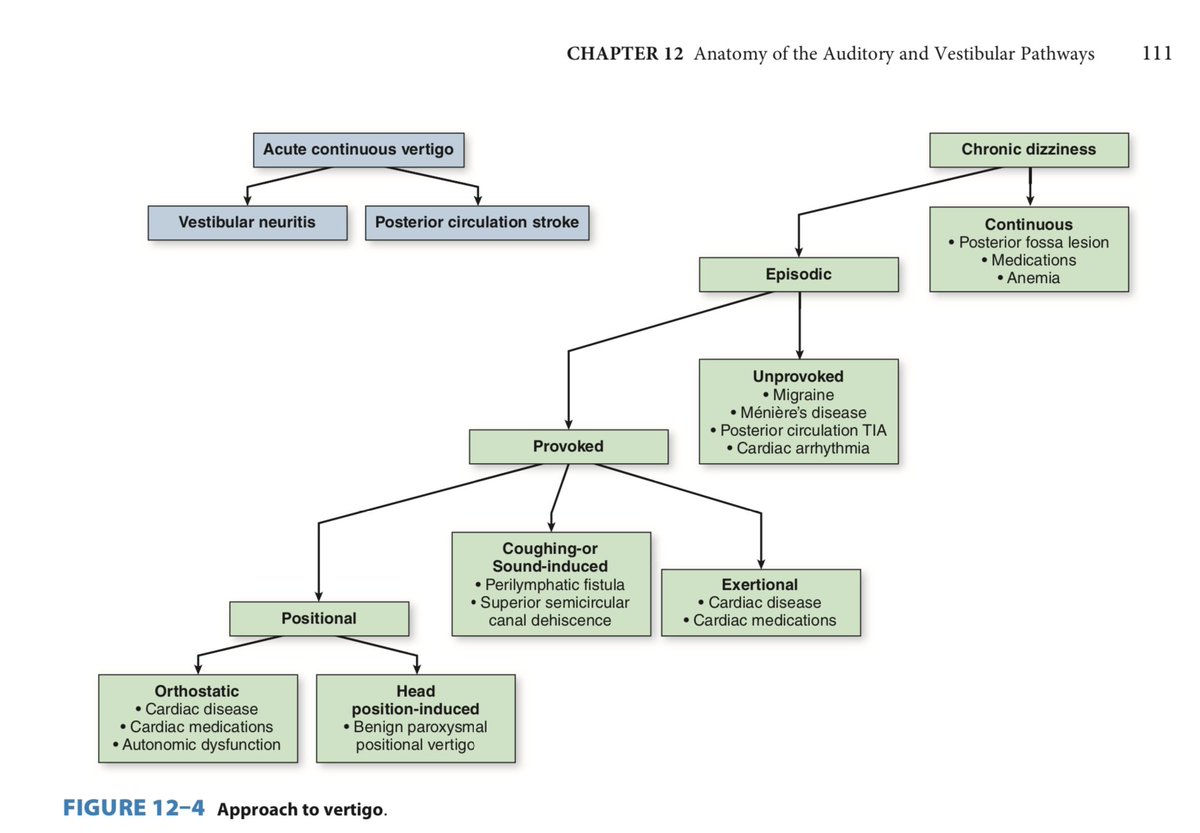It's complicated, so here is a #Tweetorial on Dizziness!
#MedEd #MedStudentTwitter #MedStudents #neurology
cc: @Tracey1milligan @MadSattinJ @CPSolvers @rabihmgeha @DxRxEdu @AANMember @ContinuumAAN 1/
Try to determine if the dizziness falls into one of these categories:
1 Vertigo (sense of movement)= neurologic or inner ear
2 Light-headed=CV related
3 Dysequilibrium=gait issue
4 other=anxiety
This classic paper is worth the read ncbi.nlm.nih.gov/pubmed/4401538
2/
Still it's a good place to start...
3/
For timing: Acute v chronic?
(We’ll come back to acute)
For chronic: continuous v episodic
For episodic: unprovoked v provoked
If provoked: provoked by what? (triggers)
See attached flow chart from amazon.com/Lange-Clinical…
4/

Is it a life-threatening posterior circulation stroke or a benign case of vestibular neuritis?
@DNewmanToker to the rescue with the HINTS exam: ncbi.nlm.nih.gov/pubmed/19762709
5/
HINTS stands for
Head Impulse
Nystagmus
Test of Skew
6/
When you turn your head to the left, your eyes turn to the right
When you turn your head to the right your eyes turn to the leift.
This is the Vestibulo-ocular reflex or VOR.
7/
Head movement detected in inner ear, transmitted to brainstem by CN 8, CN 8 communicates with CN 3/4/6 to move eyes conjugately in direction opposite head motion.
Brain knows direction head is turning by COMPARING the activity in the L and R CN 8.
8/
If we turn head to the RIGHT, R CN8 gets more excited. Brain detects R>L = head turn to right->sends eyes to LEFT
Got it?
9/
Also note:
Both CN8s are tonically active at baseline --you'll see why that's important...
10/
Let’s say it’s on the LEFT
So left CN 8 is not working well and its baseline tonic activity therefore stops
BUT healthy RIGHT CN8 continues its tonic activity!
So the brain sees: R> L (i.e., something > 0)…
11/
but the head ISN'T turning so we flick the eyes back to the RIGHT…
deviate to left, flick to right…deviate to left flick to right.
It’s nystagmus!
12/
Slow phase toward abnormal side and fast phase toward normal side (just like normal cold calorics).
So nystagmus has a CONSTANT direction in a unilateral peripheral etiology.
13/
the fast phase is ALWAYS in the direction of gaze: left beating on left gaze; right beating on right gaze…
14/
Direction-changing nystagmus in acute onset vertigo = concerning for stroke.
Nystagmus with fast phase in same direction in all positions of gaze = peripheral
15/
Asking patient to fixate on your nose, move their head briskly to each side: eyes should instantly move in direction opposite to head movement to stay on nose.
16/
When we move the head to the left, the CN8 isn’t working to transmit the message to the eyes that the head has moved…
so the eyes move with the head and have to catch up to find the nose= abnormal...
17/
It’s a NORMAL HIT that’s worrisome in the case of acute vertigo!
*Note NORMAL HIT in acute vertigo = worry about stroke!*
18/
If the eyes are looking in wildly different directions it’s not hard to call it central.
19/
If so, test is positive...in acute vertigo, positive test = concerning for stroke!
20/
Impulse Normal
Fast-phase-of-nystagmus Alternating
Refixation on Cover Test…
21/
(note this applies only to acute continuous vertigo)
Feeling dizzy?
22/


